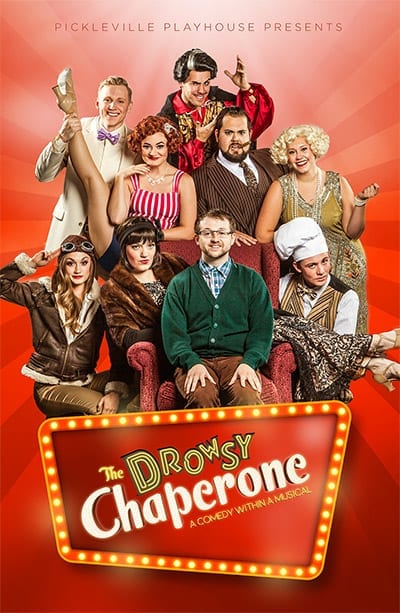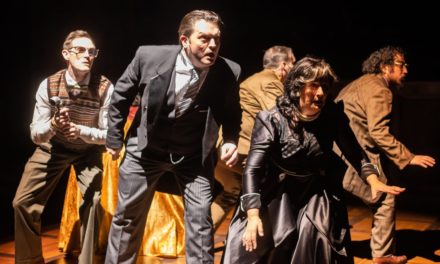RICH COUNTY — With a title like The Drowsy Chaperone, and promotional material that generally features an armchair or a record player, I’ve never been that interested in attending this play. It was only because a review was requested, and because that request came from Pickleville Playhouse, that I decided to check it out. And from the quirky monologue that begins the show, to the casual snacking post-intermission, and all the way through the touching final number, I was so pleased that I had.
In this play, written by Bob Martin and Don McKeller, I discovered that the iconic armchair lives in the home of the show’s main character. Simply named Man in Chair, Jordan Todd Brown sits down on a melancholy evening to enjoy his favorite musical theatre record, “The Drowsy Chaperone.” It’s a fun and ridiculous show with music and lyrics by Lisa Lambert and Greg Morrison. With characters like two pastry chef gangsters, a fame-hungry blonde, and a dramatic Latin lover, it has a very simple plot: the wealthy Robert Martin is marrying the famous Janet Van De Graff, who will be leaving the limelight behind; but when not everyone wants the two of them together, things begin to go awry. So with the premise laid out, let’s take a look at the production.
Janet Van De Graff explains her desire for married life in, “I Don’t Want To Show Off.” While singing the clever ironic lyrics of this song, and executing the choreography, Whitley O Davis dazzles like the star she portrays. She had a terrific team (including choreographer Sharli King) helping her manage costume changes, prop juggling, and one trick after another. Davis’ lifted split was super impressive. “I Don’t Want To Show Off,” was one of the most memorable scenes of the night, and I still can’t get the tune out of my head. Derek Davis played Robert Martin, the groom-to-be, who is honestly a pretty vanilla character. But Davis stood out with his skilled tap dancing in “Cold Feet,” and his intentionally clumsy roller-skating. The titular role of the Drowsy Chaperone belonged to Kassandra Winkler, a divine vocalist. She has a deep, smooth singing voice, and her performance justified the admiration of Man In Chair.
In a comedic production like this one, with many strong/loud/vibrant characters, it’s important for each actor—and their directors (T.J. and Derek Davis)—to choose wisely the moments and character traits he/she will emphasize. Because when every person is asking for attention at the same time, it can cause sensory overload. I only felt this over-intensity once or twice, but I feel like it’s a noteworthy observation. Jordan Todd Brown’s commentary as Man in Chair did wonders to balance things out.
The costume designs (attributed to Rosie Fullmer, Carolyn Passey, Erin Davis, Andrea Davis, and Kasi French) reflected the showy, shiny attributes of the musical. As Man In Chair’s favorite character, the costuming team made Chaperone stand out in a beautiful way. Her elegant ensembles were my favorites of the show. She wore a red sparkly shawl of sorts that glittered in the spotlight during her big solo, and a gold sequined dress that overshadowed the other women in the wedding scene. The stage was also well dressed, thanks to Kenneth Bell, Derek Davis, and James Oswald. The Man In Chair has his compact apartment, and the main stage houses his kitchen until it is overtaken by the musical he is envisioning. I liked the unremarkable, yet cared for, details of the Man’s home, like his albums neatly leaning on a shelf below the record player. The sets blended together nicely; his refrigerator became an entrance for the Broadway actors, and his bookshelves ultimately formed an aircraft.
Because the script was written in 1997, I was surprised by some of the contemporary references, like global warming, gay weddings, and the annoyance of cell phone interruptions. I didn’t think those topics had gained momentum in the 90s. I know that Pickleville made a few changes to more risqué lines, to make the show family friendly, but I’m interested to know how or whether the script has changed since ’97. The Drowsy Chaperone is described as a “comedy within a musical,” which places it in the “play within a play” category of theatre. These types of scripts are special because they comment on theatre itself; they vocalize the thoughts of theatre artists and attendees. In The Drowsy Chaperone, these insights come from the character Man In Chair, an awkward and sweet musical theatre aficionado. Jordan Todd Brown wowed me in this role. I was touched by his excitement when the overture began, and I appreciated his timing and patience for Man’s clever, jaded commentary. One of my favorite lines was, “Mature contemporary audiences are too sophisticated to enjoy broad racial stereotypes on the stage. So we’ve banished them to Disney. Let the children sort it out.” Brown’s monologue about living or leaving solidified his brilliant performance for me, and I could hardly wait to give him a standing ovation. The lighting design (by Josh Roberts and Mark Duerden) was essential in the transitions from Man-In-Chair-scenes to scenes from the musical; they told the audience where to focus. Lights even acted as a mute button for when the phone rang or the superintendent knocked at the door.
I admit that I’ve saved a little pedestal for Pickleville over the years. With such a talented, hard-working cast and crew, a group of people so excited about what they do—how could I not? The Drowsy Chaperone is a delightful play, and what a treat it was to have my first experience with it at Pickleville Playhouse. To owner Andrea Davis: there is something really special about that place and the work that you produce.






